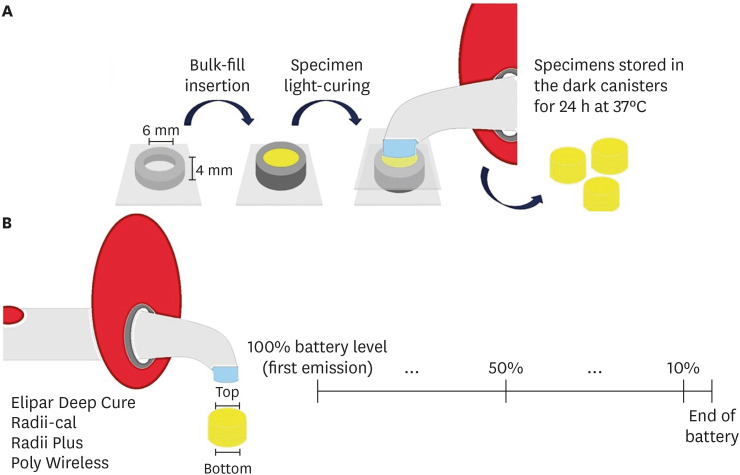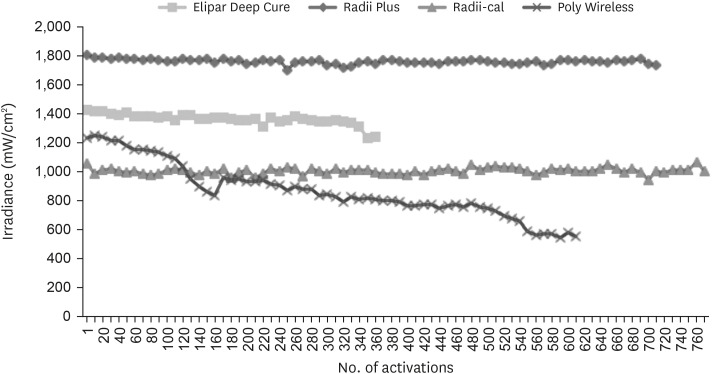Restor Dent Endod.
2022 Nov;47(4):e45. 10.5395/rde.2022.47.e45.
Relationship between battery level and irradiance of light-curing units and their effects on the hardness of a bulk-fill composite resin
- Affiliations
-
- 1School of Health Sciences, Graduate Program in Dentistry, Universidade Positivo, Curitiba, PR, Brazil
- KMID: 2548166
- DOI: http://doi.org/10.5395/rde.2022.47.e45
Abstract
Objectives
This study evaluated the relationship between the battery charge level and irradiance of light-emitting diode (LED) light-curing units (LCUs) and how these variables influence the Vickers hardness number (VHN) of a bulk-fill resin.
Materials and Methods
Four LCUs were evaluated: Radii Plus (SDI), Radii-cal (SDI), Elipar Deep Cure (Filtek Bulk Fill, 3M Oral Care), and Poly Wireless (Kavo Kerr). Irradiance was measured using a radiometer every ten 20-second activations until the battery was discharged. Disks (4 mm thick) of a bulk-fill resin (Filtek Bulk Fill, 3M Oral Care) were prepared, and the VHN was determined on the top and bottom surfaces when light-cured with the LCUs with battery levels at 100%, 50% and 10%. Data were analyzed by 2-way analysis of variance, the Tukey’s test, and Pearson correlations (α = 5%).
Results
Elipar Deep Cure and Poly Wireless showed significant differences between the irradiance when the battery was fully charged versus discharged (10% battery level). Significant differences in irradiance were detected among all LCUs, within each battery condition tested. Hardness ratios below 80% were obtained for Radii-cal (10% battery level) and for Poly Wireless (50% and 10% battery levels). The battery level showed moderate and strong, but non-significant, positive correlations with the VHN and irradiance.
Conclusions
Although the irradiance was different among LCUs, it decreased in half of the devices along with a reduction in battery level. In addition, the composite resin effectiveness of curing, measured by the hardness ratio, was reduced when the LCUs’ battery was discharged.
Keyword
Figure
Reference
-
1. Miletic V, Pongprueksa P, De Munck J, Brooks NR, Van Meerbeek B. Curing characteristics of flowable and sculptable bulk-fill composites. Clin Oral Investig. 2017; 21:1201–1212.
Article2. Son SA, Park JK, Seo DG, Ko CC, Kwon YH. How light attenuation and filler content affect the microhardness and polymerization shrinkage and translucency of bulk-fill composites? Clin Oral Investig. 2017; 21:559–565.
Article3. Bucuta S, Ilie N. Light transmittance and micro-mechanical properties of bulk fill vs. conventional resin based composites. Clin Oral Investig. 2014; 18:1991–2000.
Article4. Li X, Pongprueksa P, Van Meerbeek B, De Munck J. Curing profile of bulk-fill resin-based composites. J Dent. 2015; 43:664–672. PMID: 25597265.
Article5. Engelhardt F, Hahnel S, Preis V, Rosentritt M. Comparison of flowable bulk-fill and flowable resin-based composites: an in vitro analysis. Clin Oral Investig. 2016; 20:2123–2130.
Article6. Ferracane JL. Current trends in dental composites. Crit Rev Oral Biol Med. 1995; 6:302–318. PMID: 8664421.
Article7. Ferracane JL, Mitchem JC, Condon JR, Todd R. Wear and marginal breakdown of composites with various degrees of cure. J Dent Res. 1997; 76:1508–1516. PMID: 9240388.
Article8. Papadogiannis D, Tolidis K, Gerasimou P, Lakes R, Papadogiannis Y. Viscoelastic properties, creep behavior and degree of conversion of bulk fill composite resins. Dent Mater. 2015; 31:1533–1541. PMID: 26498511.
Article9. Pongprueksa P, De Munck J, Duca RC, Poels K, Covaci A, Hoet P, Godderis L, Van Meerbeek B, Van Landuyt KL. Monomer elution in relation to degree of conversion for different types of composite. J Dent. 2015; 43:1448–1455. PMID: 26498727.
Article10. Garoushi S, Vallittu P, Shinya A, Lassila L. Influence of increment thickness on light transmission, degree of conversion and micro hardness of bulk fill composites. Odontology. 2016; 104:291–297. PMID: 26660101.
Article11. Musanje L, Darvell BW. Curing-light attenuation in filled-resin restorative materials. Dent Mater. 2006; 22:804–817. PMID: 16364419.
Article12. Sideridou I, Tserki V, Papanastasiou G. Effect of chemical structure on degree of conversion in light-cured dimethacrylate-based dental resins. Biomaterials. 2002; 23:1819–1829. PMID: 11950052.
Article13. Musanje L, Ferracane JL, Sakaguchi RL. Determination of the optimal photoinitiator concentration in dental composites based on essential material properties. Dent Mater. 2009; 25:994–1000. PMID: 19328539.
Article14. Kowalska A, Sokolowski J, Bociong K. The photoinitiators used in resin based dental composite-a review and future perspectives. Polymers (Basel). 2021; 13:470. PMID: 33540697.
Article15. Price RB, Whalen JM, Price TB, Felix CM, Fahey J. The effect of specimen temperature on the polymerization of a resin-composite. Dent Mater. 2011; 27:983–989. PMID: 21798590.
Article16. Dugan WT, Hartleb JH. Influence of a glutaraldehyde disinfecting solution on curing light effectiveness. Gen Dent. 1989; 37:40–43. PMID: 2513242.17. Pollack BF, Lewis AL. Visible light resin-curing generators: a comparison. Gen Dent. 1981; 29:488–493. PMID: 6948747.18. Yearn JA. Factors affecting cure of visible light activated composites. Int Dent J. 1985; 35:218–225. PMID: 2932391.19. Soares CJ, Rodrigues MP, Oliveira LR, Braga SS, Barcelos LM, Silva GR, Giannini M, Price RB. An evaluation of the light output from 22 contemporary light curing units. Braz Dent J. 2017; 28:362–371. PMID: 29297558.
Article20. Jafarzadeh TS, Erfan M, Behroozibakhsh M, Fatemi M, Masaeli R, Rezaei Y, Bagheri H, Erfan Y. Evaluation of polymerization efficacy in composite resins via FT-IR spectroscopy and Vickers microhardness test. J Dent Res Dent Clin Dent Prospect. 2015; 9:226–232.
Article21. Price RB, Felix CA, Andreou P. Effects of resin composite composition and irradiation distance on the performance of curing lights. Biomaterials. 2004; 25:4465–4477. PMID: 15046937.
Article22. Price RB, Ferracane JL, Shortall AC. Light-curing units: a review of what we need to know. J Dent Res. 2015; 94:1179–1186. PMID: 26156516.23. Moldovan M, Balazsi R, Soanca A, Roman A, Sarosi C, Prodan D, Vlassa M, Cojocaru I, Saceleanu V, Cristescu I. Evaluation of the degree of conversion, residual monomers and mechanical properties of some light-cured dental resin composites. Materials (Basel). 2019; 12:2109. PMID: 31262014.
Article24. Maktabi H, Balhaddad AA, Alkhubaizi Q, Strassler H, Melo MA. Factors influencing success of radiant exposure in light-curing posterior dental composite in the clinical setting. Am J Dent. 2018; 31:320–328. PMID: 30658380.25. Tongtaksin A, Leevailoj C. Battery charge affects the stability of light intensity from light-emitting diode light-curing units. Oper Dent. 2017; 42:497–504. PMID: 28581918.
Article26. Al Shaafi M, Maawadh A, Al Qahtani M. Evaluation of light intensity output of QTH and LED curing devices in various governmental health institutions. Oper Dent. 2011; 36:356–361. PMID: 21834709.
Article27. Alquria T, Al Gady M, Khabeer A, Ali S. Types of polymerisation units and their intensity output in private dental clinics of twin cities in eastern province, KSA; a pilot study. J Taibah Univ Med Sci. 2018; 14:47–51. PMID: 31435389.
Article28. Omidi BR, Gosili A, Jaber-Ansari M, Mahdkhah A. Intensity output and effectiveness of light curing units in dental offices. J Clin Exp Dent. 2018; 10:e555–e560. PMID: 29946413.
Article29. Nomoto R, McCabe JF, Nitta K, Hirano S. Relative efficiency of radiation sources for photopolymerization. Odontology. 2009; 97:109–114. PMID: 19639454.
Article30. Price RB, Labrie D, Kazmi S, Fahey J, Felix CM. Intra- and inter-brand accuracy of four dental radiometers. Clin Oral Investig. 2012; 16:707–717.
Article31. Roberts HW, Vandewalle KS, Berzins DW, Charlton DG. Accuracy of LED and halogen radiometers using different light sources. J Esthet Restor Dent. 2006; 18:214–222. PMID: 16911424.
Article32. Rueggeberg FA, Caughman WF, Curtis JW Jr. Effect of light intensity and exposure duration on cure of resin composite. Oper Dent. 1994; 19:26–32. PMID: 8183730.33. Halvorson RH, Erickson RL, Davidson CL. Energy dependent polymerization of resin-based composite. Dent Mater. 2002; 18:463–469. PMID: 12098575.35. Yap AU, Seneviratne C. Influence of light energy density on effectiveness of composite cure. Oper Dent. 2001; 26:460–466. PMID: 11551010.36. Takamizu M, Moore BK, Setcos JC, Phillips RW. Efficacy of visible-light generators with changes in voltage. Oper Dent. 1988; 13:173–180. PMID: 3268786.37. El-Damanhoury H, Platt J. Polymerization shrinkage stress kinetics and related properties of bulk-fill resin composites. Oper Dent. 2014; 39:374–382. PMID: 23865582.
Article38. Alshali RZ, Silikas N, Satterthwaite JD. Degree of conversion of bulk-fill compared to conventional resin-composites at two time intervals. Dent Mater. 2013; 29:e213–e217. PMID: 23845799.
Article39. Flury S, Peutzfeldt A, Lussi A. Influence of increment thickness on microhardness and dentin bond strength of bulk fill resin composites. Dent Mater. 2014; 30:1104–1112. PMID: 25086481.
Article40. de Camargo EJ, Moreschi E, Baseggio W, Cury JA, Pascotto RC. Composite depth of cure using four polymerization techniques. J Appl Oral Sci. 2009; 17:446–450. PMID: 19936524.
Article41. Moore BK, Platt JA, Borges G, Chu TM, Katsilieri I. Depth of cure of dental resin composites: ISO 4049 depth and microhardness of types of materials and shades. Oper Dent. 2008; 33:408–412. PMID: 18666498.
Article42. Pilo R, Cardash HS. Post-irradiation polymerization of different anterior and posterior visible light-activated resin composites. Dent Mater. 1992; 8:299–304. PMID: 1303371.
Article43. Schattenberg A, Lichtenberg D, Stender E, Willershausen B, Ernst CP. Minimal exposure time of different LED-curing devices. Dent Mater. 2008; 24:1043–1049. PMID: 18241913.
Article44. Konerding KL, Heyder M, Kranz S, Guellmar A, Voelpel A, Watts DC, Jandt KD, Sigusch BW. Study of energy transfer by different light curing units into a class III restoration as a function of tilt angle and distance, using a MARC Patient Simulator (PS). Dent Mater. 2016; 32:676–686. PMID: 27017156.
Article
- Full Text Links
- Actions
-
Cited
- CITED
-
- Close
- Share
- Similar articles
-
- Comparison of Surface Microhardness of the Flowable Bulk-Fill Resin and the Packable Bulk-Fill Resin according to Light Curing Time and Distance
- Evaluation of marginal leakage of bulk fill flowable composite resin filling with different curing time using micro-computed tomography technology
- Effect of resin thickness on the microhardness and optical properties of bulk-fill resin composites
- Errors in light-emitting diodes positioning when curing bulk fill and incremental composites: impact on properties after aging
- Color evaluation of low viscosity bulk-fill resin with composite resin capping layer



